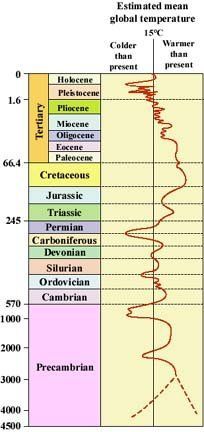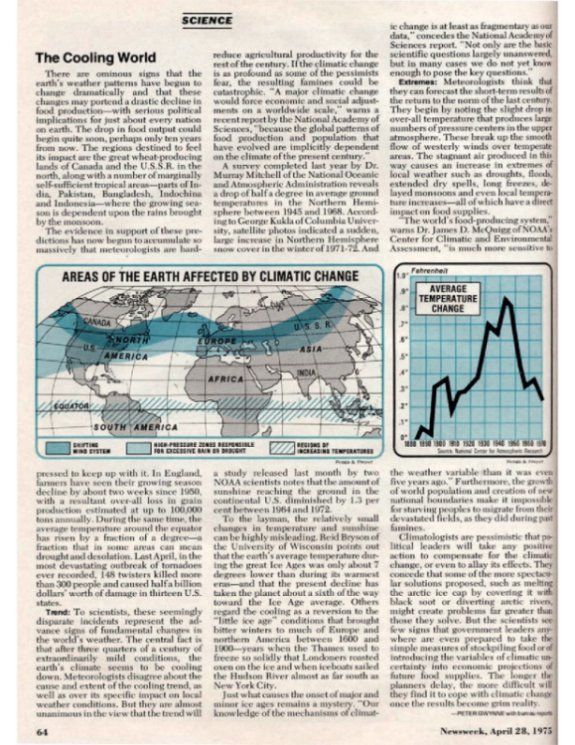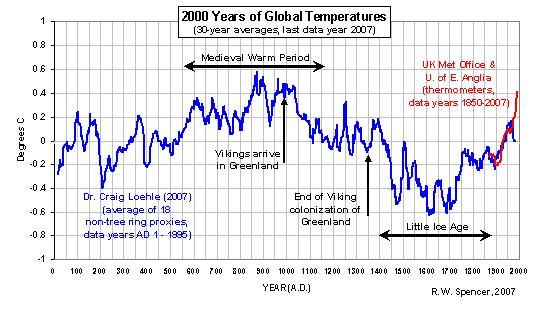Global Warming and Cooling
Dec 10, 2013 13:16:39 GMT -5
bushmanbilly, GeorgeStoneStore, and 1 more like this
Post by 1dave on Dec 10, 2013 13:16:39 GMT -5
Global Warming? I found the following charts on line:


During the geological history of the earth, it appears there have been 5 major periods of rock building.
What accounted for sudden increases in rock production?
My best guess is a large asteroid impact.
We have entered a strange period of “Mob Science.”
I believe that some ‘scientists’ want research grants so desperately that they purposely fake the data on their pet projects to panic people. The sad thing is that it is working. At present this subject is so politically charged that it is hard to ferret out the truth. Most paleoclimatology charts are restricted to the recent past to confuse the issue. One sane voice is:
www.ncdc.noaa.gov/paleo/globalwarming/climate.html
From 1940 to 1975 the world experienced a 35 year cooling period. This convinced some 1970's, scientists that we had to do something drastic like blackening the ice around the poles to warm up the planet. A warming trend followed. Where would we be today if we had listened to them?

Some of today’s scientists are in full panic mode about the mild temperature rise we are presently experiencing. They are demanding a full scale assault to get back to “normal.”
The mob mentality is back.
What is NORMAL? The fact is, THERE IS NO STATUS QUO! Never has been, never will be.

Here are the recent facts:
This planet has two sources of heat:
I. The Sun
1. The Sun itself may not be consistent. There are possible correlations to Temperature changes and Sunspot activity. What can we do about that?
2. The output from the Sun may be blocked bey varying amounts of Zodiac Dust. More about this later.
3. Changes in Earth’s orbit may cause variations.
deschutes.gso.uri.edu/~rutherfo/milankovitch.html
4. The output from the Sun may be blocked by Earth’s atmospheric contaminants.
II. Heat generated in the core of the planet.
1. Whether this is generated by compression, tidal slippage, nuclear reactions, or some other mechanism, plumes of molten materials constantly rise and erupt through volcanoes.
A single volcanic eruption can place more pollutants into the atmosphere than mankind has been able to generate in the last 10,000 years.
There are over 60 volcanic eruptions every year. What can we do to change that?
Those eruptions also interfere with the heat we receive from the sun, but so do MANY other things. Forest Fires have blocked out sunlight for as long as there have been forests. There is even talk of the problem resulting from methane being released from mammals. A recent study suggests that the loss of ships and airplanes in the Bermuda Triangle may be the results of huge amounts of fossil fuel gases being naturally released from the sea bottoms ... that we are not allowed to harvest. What can we do about that?
Do mid ocean eruptions effect ocean temperatures? www.coaps.fsu.edu/lib/elninolinks/themes/
We have many ways to examine ancient temperatures:
Atmospheric gases and other materials trapped in glaciers provide compelling evidence.
Tree rings record temperature changes for several thousand years into the recent past. Petrified wood and fossil remains of other creatures can take us back much further.
The Geological record provides information going back at least three billion years. Some of the Glaciation episodes have been attributed to asteroid impacts. What can we do about that?
www.cpluhna.nau.edu/Research/paleoof_southern_coloplat.htm
From Paleoclimatology we now know the Earth has been far hotter and far colder than it is right now! Again, there is no status quo in temperature fluctuations.
There are many theories attempting to explain these cycling changes. Many of them far more compelling than the Greenhouse theory that is now all the rage.
At present, the best fit I have found to the accepted data* is that put forward by D.J. Asher and S.V.M. Clube of the Department of Physics, University of Oxford, UK 1992, August 24.The title of their paper is Extraterrestrial Influences, found in the Royal Astronomical Society Quarterly Journal 1993 Vol. 34, pp 481-511.
In short, they present evidence that a large comet penetrated into the inner solar system about 20,000 years ago. It broke up in the vicinity of Jupiter’s orbit, and the remnants are now identified as the “Taurid Complex.” Ongoing collisions within the complex occur near Jupiter with huge asteroids (around 100KM in diameter) whose orbits intersect with Comet P/Enccke. They are all assumed to be pieces of the once giant comet.
These impacts periodically enhance the Comet P/Encke, which has a period of 3.39 years with modulations of 23.7 years and 200 years, and produce much more zodiac dust. This dramatically alters the amount of sunlight reaching the planets. That may explain why Mars is warming right now.
Probable Taurids are: 1991 GO, 4341 Poiseidon, 4197 1982 TA, 1991 TB2, 1984 KB, 4183 Cuno, 2201 Oljato, 5143 1991 VL, 1991 BA.
Also, The Hephistos group: 1991 AQ, 2212 Hephistos, 1990 TG I, 1990 SM, 4486 Mithra, and the “Stray Object” Adonis.
* Beginning about 2 million years ago we have “The IceAges”:
G or IG (Glacial, (Inter-Glacial)
mya American/European
1.8 G - /Donau
1.4 IG Pre Glacial/Donau-Gunz
0.79 G Nebrascan/Gunzian
0.49 IG Aftonian/Gunz-Mindel
0.39 G Kansan/Mendel
0.19 IG Yarmouth/Mindel Riss
0.13 G Illinoian/Riss (Impact Craters in Germany)
0.10 IG Songamonian/Riss-Wurm
0.06 G Wisconsin/Wurmian
Recent cold shifts are:
2,000BC
1300AD Wolf
1500AD Sporer
1700AD Maunder
1900AD Which was the coldest to occur in the past thousand years.
2100AD ? Are we headed into another cold period?
Interestingly, Glacier National Park was Organized in 1930, shortly after this latest cold spell.
Unique isotopes found in the Taurids are consistent with anomalies found in living matter taken from the 200 year fluctuations.
The Taurid Complex meteor stream interacts with Earth every Halloween, producing the Taurus Meteor showers.
Could the augmented meteorite falls and cold of 1300, 1500, 1700AD account for the fears resulting in the persistence of Halloween?


During the geological history of the earth, it appears there have been 5 major periods of rock building.
Although cooling of the Earth’s a continuous process, the rate of advective heat transfer may have fluctuated throughout geologic time. Evidence for this comes from the rate of production of rocks which does not appear to have remained constant. Despite the incompleteness of the geologic record, in particular of the Precambrian, most rocks were formed during distinct episodes. According to Moorbath (1977) these occurred between 3.8 and 3.5, 2.9 and 2.6, 1.9 and 1.6, 1.2 and 0.9. and 0.6 and 0 Ga ago.
Because these episodes appear to be world wide in extent, they probably reflect major periods of advection tn the mantle and possibly the core.
Certain rock types, such as tholeiitic basalt and green-schists. have formed throughout geologic time. but others are restricted to specific rock—forming episodes (see Sec. 14-8).
Greenstone belts, for example, are formed in the first two episodes: massif-type anorthosites and widespread granulite facies metamorphism characterize the 1.2 to 0.9—Ga episode, and low-T, high-P metamorphic rocks are restricted to the most recent episode (the latter group may have formed in the Precambrian but are not preserved due to erosion or continued heating at depth).
These changes must reflect evolution of the planet’s interior as a result of progressive cooling. This evolution can be expected to continue, with the rate of production of new rocks decreasing as the Earth cools. Eventually, the rate of heat production will be insufficient to maintain advection. Then Earth will cease to be a dynamic planet, and no new rocks will be formed.
- Principles of Igneous and Metamorphic Petrology by Anthony R. Philpotts
Section 22 - Origin of Rocks p 422
Because these episodes appear to be world wide in extent, they probably reflect major periods of advection tn the mantle and possibly the core.
Certain rock types, such as tholeiitic basalt and green-schists. have formed throughout geologic time. but others are restricted to specific rock—forming episodes (see Sec. 14-8).
Greenstone belts, for example, are formed in the first two episodes: massif-type anorthosites and widespread granulite facies metamorphism characterize the 1.2 to 0.9—Ga episode, and low-T, high-P metamorphic rocks are restricted to the most recent episode (the latter group may have formed in the Precambrian but are not preserved due to erosion or continued heating at depth).
These changes must reflect evolution of the planet’s interior as a result of progressive cooling. This evolution can be expected to continue, with the rate of production of new rocks decreasing as the Earth cools. Eventually, the rate of heat production will be insufficient to maintain advection. Then Earth will cease to be a dynamic planet, and no new rocks will be formed.
- Principles of Igneous and Metamorphic Petrology by Anthony R. Philpotts
Section 22 - Origin of Rocks p 422
What accounted for sudden increases in rock production?
My best guess is a large asteroid impact.
We have entered a strange period of “Mob Science.”
I believe that some ‘scientists’ want research grants so desperately that they purposely fake the data on their pet projects to panic people. The sad thing is that it is working. At present this subject is so politically charged that it is hard to ferret out the truth. Most paleoclimatology charts are restricted to the recent past to confuse the issue. One sane voice is:
www.ncdc.noaa.gov/paleo/globalwarming/climate.html
From 1940 to 1975 the world experienced a 35 year cooling period. This convinced some 1970's, scientists that we had to do something drastic like blackening the ice around the poles to warm up the planet. A warming trend followed. Where would we be today if we had listened to them?

Some of today’s scientists are in full panic mode about the mild temperature rise we are presently experiencing. They are demanding a full scale assault to get back to “normal.”
The mob mentality is back.
What is NORMAL? The fact is, THERE IS NO STATUS QUO! Never has been, never will be.

Here are the recent facts:
“For the last 25 years, we have had the benefit of temperature data that have been collected by satellite mounted Microwave Sounding Units (MSU5), which are able to take broad consistent measurements of the earth’s lower atmosphere over 95 percent of the earth’s surface. These satellite data are widely considered one of the most accurate measurements of the global climate.
MSU5 data over the last 25 years show that the earth’s temperature has warmed about 0.19 degrees Celsius in that amount of time.
Scientists say much of that warming can be explained by the El Nino of 1998. The satellite data show there was little or no warming in the southern latitudes or tropics.”
-Personal communication from Senator Orrin Hatch
MSU5 data over the last 25 years show that the earth’s temperature has warmed about 0.19 degrees Celsius in that amount of time.
Scientists say much of that warming can be explained by the El Nino of 1998. The satellite data show there was little or no warming in the southern latitudes or tropics.”
-Personal communication from Senator Orrin Hatch
This planet has two sources of heat:
I. The Sun
1. The Sun itself may not be consistent. There are possible correlations to Temperature changes and Sunspot activity. What can we do about that?
2. The output from the Sun may be blocked bey varying amounts of Zodiac Dust. More about this later.
3. Changes in Earth’s orbit may cause variations.
deschutes.gso.uri.edu/~rutherfo/milankovitch.html
4. The output from the Sun may be blocked by Earth’s atmospheric contaminants.
II. Heat generated in the core of the planet.
1. Whether this is generated by compression, tidal slippage, nuclear reactions, or some other mechanism, plumes of molten materials constantly rise and erupt through volcanoes.
A single volcanic eruption can place more pollutants into the atmosphere than mankind has been able to generate in the last 10,000 years.
There are over 60 volcanic eruptions every year. What can we do to change that?
Those eruptions also interfere with the heat we receive from the sun, but so do MANY other things. Forest Fires have blocked out sunlight for as long as there have been forests. There is even talk of the problem resulting from methane being released from mammals. A recent study suggests that the loss of ships and airplanes in the Bermuda Triangle may be the results of huge amounts of fossil fuel gases being naturally released from the sea bottoms ... that we are not allowed to harvest. What can we do about that?
Do mid ocean eruptions effect ocean temperatures? www.coaps.fsu.edu/lib/elninolinks/themes/
We have many ways to examine ancient temperatures:
Atmospheric gases and other materials trapped in glaciers provide compelling evidence.
Tree rings record temperature changes for several thousand years into the recent past. Petrified wood and fossil remains of other creatures can take us back much further.
The Geological record provides information going back at least three billion years. Some of the Glaciation episodes have been attributed to asteroid impacts. What can we do about that?
www.cpluhna.nau.edu/Research/paleoof_southern_coloplat.htm
From Paleoclimatology we now know the Earth has been far hotter and far colder than it is right now! Again, there is no status quo in temperature fluctuations.
There are many theories attempting to explain these cycling changes. Many of them far more compelling than the Greenhouse theory that is now all the rage.
At present, the best fit I have found to the accepted data* is that put forward by D.J. Asher and S.V.M. Clube of the Department of Physics, University of Oxford, UK 1992, August 24.The title of their paper is Extraterrestrial Influences, found in the Royal Astronomical Society Quarterly Journal 1993 Vol. 34, pp 481-511.
In short, they present evidence that a large comet penetrated into the inner solar system about 20,000 years ago. It broke up in the vicinity of Jupiter’s orbit, and the remnants are now identified as the “Taurid Complex.” Ongoing collisions within the complex occur near Jupiter with huge asteroids (around 100KM in diameter) whose orbits intersect with Comet P/Enccke. They are all assumed to be pieces of the once giant comet.
These impacts periodically enhance the Comet P/Encke, which has a period of 3.39 years with modulations of 23.7 years and 200 years, and produce much more zodiac dust. This dramatically alters the amount of sunlight reaching the planets. That may explain why Mars is warming right now.
Probable Taurids are: 1991 GO, 4341 Poiseidon, 4197 1982 TA, 1991 TB2, 1984 KB, 4183 Cuno, 2201 Oljato, 5143 1991 VL, 1991 BA.
Also, The Hephistos group: 1991 AQ, 2212 Hephistos, 1990 TG I, 1990 SM, 4486 Mithra, and the “Stray Object” Adonis.
* Beginning about 2 million years ago we have “The IceAges”:
G or IG (Glacial, (Inter-Glacial)
mya American/European
1.8 G - /Donau
1.4 IG Pre Glacial/Donau-Gunz
0.79 G Nebrascan/Gunzian
0.49 IG Aftonian/Gunz-Mindel
0.39 G Kansan/Mendel
0.19 IG Yarmouth/Mindel Riss
0.13 G Illinoian/Riss (Impact Craters in Germany)
0.10 IG Songamonian/Riss-Wurm
0.06 G Wisconsin/Wurmian
Recent cold shifts are:
2,000BC
1300AD Wolf
1500AD Sporer
1700AD Maunder
1900AD Which was the coldest to occur in the past thousand years.
2100AD ? Are we headed into another cold period?
Interestingly, Glacier National Park was Organized in 1930, shortly after this latest cold spell.
Unique isotopes found in the Taurids are consistent with anomalies found in living matter taken from the 200 year fluctuations.
The Taurid Complex meteor stream interacts with Earth every Halloween, producing the Taurus Meteor showers.
Could the augmented meteorite falls and cold of 1300, 1500, 1700AD account for the fears resulting in the persistence of Halloween?
“Enlightened scientists” of the 18th and 19th centuries, knowing that rocks do not fall from the sky, howled in laughter as they read histories of ancient “peasants” cowering in fear when comets appeared.




















